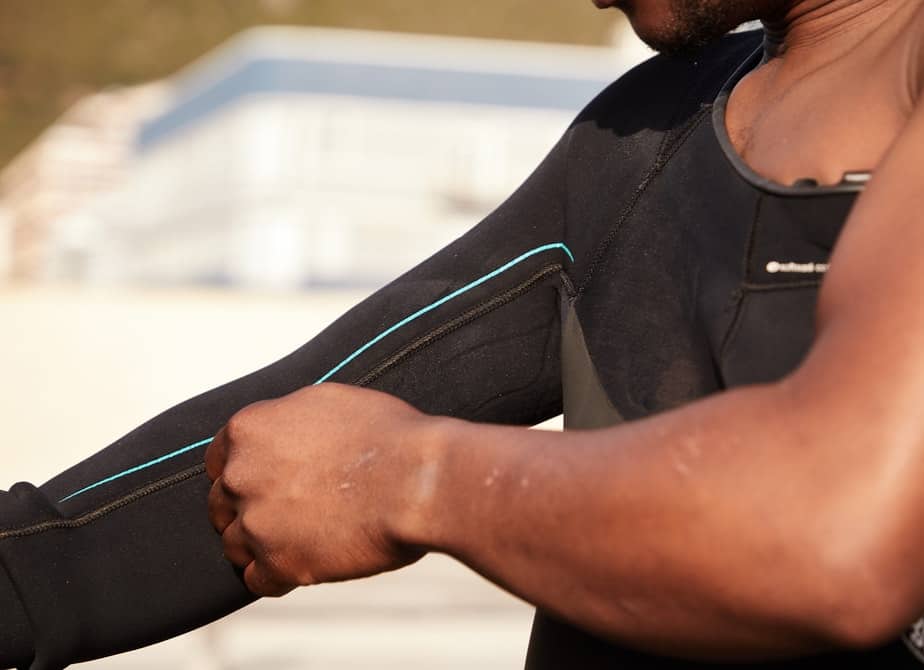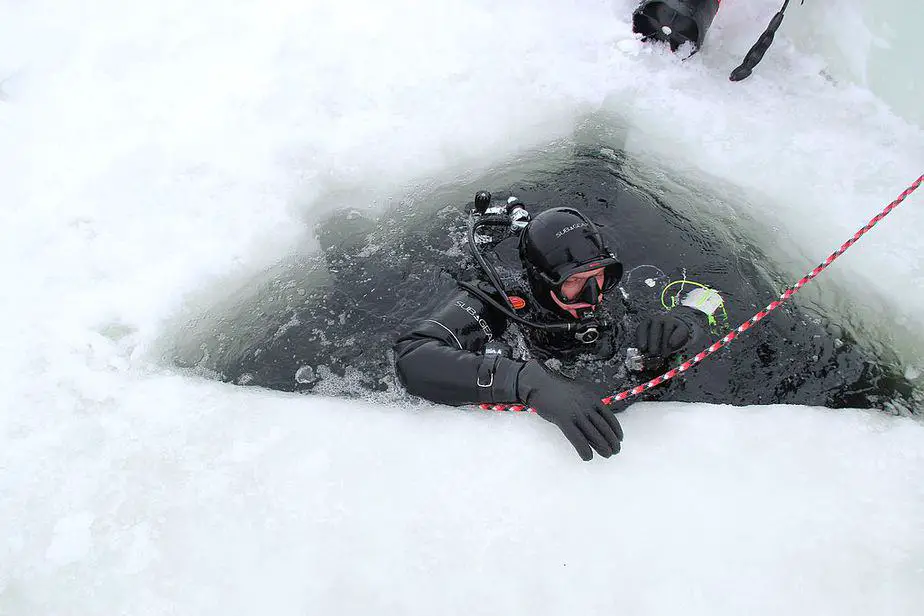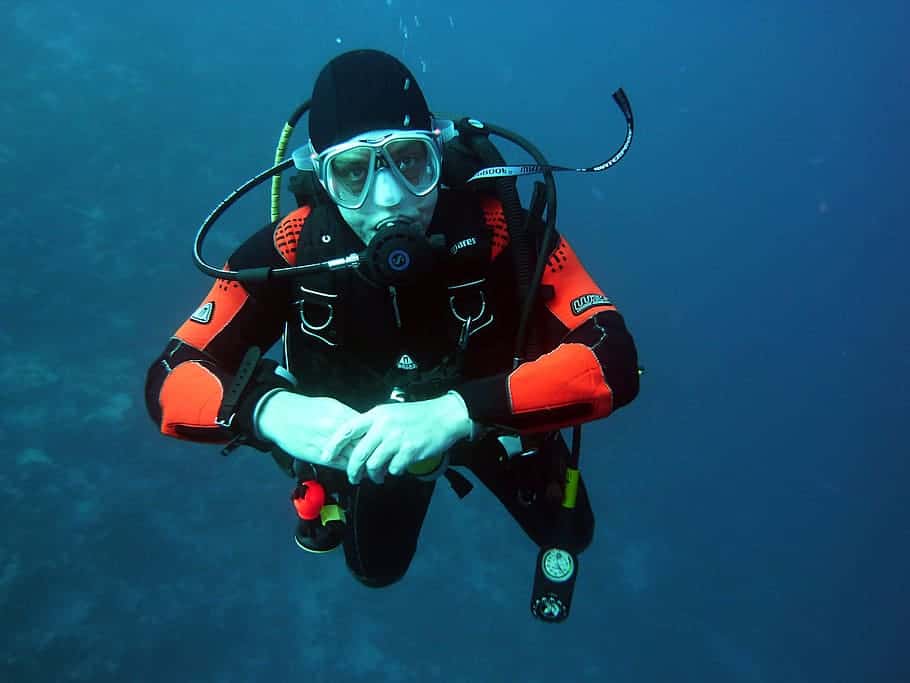Why are most of the wetsuits nowadays that are worn by people in the water or sold at dive shops black? Do surfers and scuba divers just not have any imagination and prefer drab looking clothing? No, it’s merely because coloring a wetsuit is more expensive, demand for it is low, and it offers few advantages in many applications.
Both colored wetsuits and black wetsuits have their advantages. For instance, black wetsuits tend to dry faster by absorbing more of the sun’s rays; they tend to look cleaner because it’s hard to tell if there’s dirt or wear on the material; and black can help one look slimmer or more formal. Colored wetsuits have the advantage of making one more visible during rescue situations and possibly looking nicer depending on the design.
Between a colored wetsuit and a black wetsuit, which one is better? To be honest, color doesn’t matter very much in a wetsuit. The most important thing for all wetsuits is that it fits snug and keeps you warm. In this article, we are still going to discuss possible advantages and disadvantages, however these are quite minor points overall. At the end of the day, as long as a wetsuit can provide you with sufficient insulation, UV protection, and comfort, then what color it is doesn’t really matter.
How big of a role does color play in a wetsuit?

We believe that a colored wetsuit does have some limited, practical advantages. As we mentioned, in a search and rescue situation, being more visible can increase your chances of being spotted by a rescuer.
Depending on the color and design of the wetsuit, it can make you feel good about your appearance. After all, if we bother to take care of our appearance in our day to day life, why not put the same level of attention when we are in the water?
This topic of looking good seems like a very shallow point, but it’s surprisingly deep when one looks into this topic further. Some sports psychologists believe that wetsuit color can greatly impact one’s performance in the water. Perhaps there is some truth to the saying that “clothes make the man [or woman]” after all.
You might think this next section is a bunch of mumbo-jumbo, but it was interesting for us to research this topic, and we want to share the results anyways.
Do you believe that if you dressed like a doctor or scientist, you could actually become smarter? Or if you dressed like a police officer, you could become more authoritative? Researchers have often conducted these kinds of experiments where someone would play dress up, and, almost always, the wearers were good at becoming the role despite not having the background.
Of course, there are limitations to this. Just because you are dressed as a doctor doesn’t give you the knowledge of a doctor. However, it does make people score more highly on their cognitive tests. So clearly, some kind of change is occurring.
The scary thing is, this effect could also be observed in the other direction when somebody “dressed down.” For instance, if one dressed in street clothes, they tended to do more poorly in cognitive tests than those who were wearing a lab coat.
We can take this idea further and specifically talk about color. Again, in the same way that our clothing can affect our perception of ourselves, so too can color. If you were to wear a color that does not resonate with you, there can be a negative impact on your performance. For instance, if you are a man and hate the color pink but were forced to wear a pink wetsuit, your head might not be in the right place anymore.
So if you buy into this idea that your appearance can affect your performance, then you can accept the argument that color and the design of the suit plays a major role in a wetsuit as well. And if you believe that color does not provide any advantages other than to increase your visibility, then a simple black wetsuit would probably be the winner in your eyes.
Why aren’t colored wetsuits more popular?

If you agree with what we said above regarding the benefit of color in our perception of ourselves, then you probably think that colored wetsuits are great and that there should probably be more designs available. Yet, there aren’t that many compared to how overwhelmingly available black wetsuits are. Why is that?
It’s not due to production problems. Wetsuits, like any other clothing, can be produced in any color you want. You can get gray, white, red, yellow, blue, or any combination of colors. You can get a wetsuit that expresses your personality perfectly, so why aren’t they more popular?
Let’s get the obvious out of the way. Maybe there aren’t many good looking colors or designs. Perhaps people felt like it was too gimmicky or that they didn’t look that good in a colorful wetsuit. Whatever the case, it just didn’t take off.
From the manufacturer’s perspective, adding color just costs extra money. Wetsuits are naturally black after manufacturing and it seems to do the job just fine. People are buying it as-is and aren’t complaining about the look. The demand for colored wetsuits is low, so it’s not cost-efficient for them to mass produce as many colored wetsuits as black wetsuits.
Colored wetsuits also look dirty more easily. As soon as you get any dirt or stains on the wetsuit, it will stand out like a sore thumb.
Even its advantage of being more visible than black wetsuits becomes a moot point once you’re deep underwater. Water will absorb some of the color from light, and therefore what you perceive underwater might not look the same as at the surface. First the reds will go, then orange, then yellow, and so on. Check out the video below to see this phenomenon in action.
Are colored wetsuits safer?
There is little evidence to suggest that a colorful wetsuit has better functionality than a black one. In fact, the opposite is more likely to be true, because sharks can notice the high contrast of bright wetsuits.
The reason is that to get the coloring of the wetsuit right, the wetsuit needs to be constructed from various materials that have different properties when it comes to insulation and comfort.
For instance, it’s much better for a wetsuit to be made from a single neoprene sheet. By minimizing the amount of cuts made into the material, the manufacturer does not have to do as much stitching which is better for keeping water out.
There is an argument that striped wetsuits offer protection from sharks. The belief is that black and white stripes in nature indicate a poisonous or dangerous animal, which may deter sharks from attacking. However, this has not been proven to be demonstrably true. Plus, the amount of shark attacks per year are so astronomically low that it’s statistically more likely that you get into an accident on the way to the water instead.
Black wetsuit benefits
Economic factors

During the manufacturing process for rubber, it is combined with stabilizing compounds and the end result is a black rubber. In the early days of wetsuit manufacturing, rubber was stabilized with soot, changing it from a white color to black.
Today, even though manufacturers use better stabilizers for rubber, the end result is still a black rubber. Neoprene is commonly used for wetsuit construction and it is a form of stabilized rubber. It has superior water and tear resistance to the original rubber and it naturally comes out as black.
Since black just seems to be the natural color, adding additional colors requires additional steps and extra expense. Since black is such a strong color, it would require a significant amount of dye to color over it, making colored wetsuits much more expensive than black ones.
Sun protection

Another benefit of all black neoprene is that it’s much better at absorbing UV rays from the sun than any other color. The carbon black makes the wetsuit especially dark and it ensures that the UV rays do not penetrate the material, but rather gets absorbed into it.
You might have already experienced this phenomenon if you’ve ever been inside a black car that has been left out on a hot summer day compared to a white car, which repels the most amount of sunlight. The lack of color of black causes it to absorb more photons. The next best color after black at absorbing UV radiation is red, which is why most divers either wear black or red.
Durability

Neoprene is generally a durable material, however it can still get damaged when exposed to water and stretched out, which is exactly what happens in most marine applications. Thus, it is combined with carbon black so that it can become resistant to water and stretching. It’ll last longer and provide more protection.
The color black also hides many imperfections in the suit. For instance, if it starts getting worn down over the years, or it has dirt on it, it will be harder to notice compared to a colored wetsuit. You may be able to squeeze a few more months or years out of a black wetsuit before it becomes noticeably damaged or worn down.
Warmth

Most neoprene used in wetsuit construction are known as closed-cell neoprene. This refers to the fact that during the manufacturing process, some air bubbles are trapped inside the suit. These air bubbles are necessary for insulation because they can store heat inside. There is also an added benefit of providing extra buoyancy which helps surfers and snorkelers stay afloat more easily.
The bubbles can trap heat so efficiently that it will also warm up the water around it. Thus, you should feel that the thin layer of water trapped inside the suit is warm, as is the suit itself, and this allows you to stay in the water for much longer than if you didn’t have the wetsuit.
If you want, you can even wear a thin layer underneath the wetsuit for even more insulation. You also have the choice of selecting a thicker wetsuit. Most wetsuits are 3/2, but you can also get 5/4 wetsuits or more for extra warmth.
Black pairs well with anything
You might have noticed this when deciding what to wear during your daily life, but black is a color that pairs well with any other color. If you aren’t sure what to wear, you can’t go wrong with black. The same is true of a wetsuit. You can have a regulator, snorkel, or dive watch that is a different color, and it won’t look strange next to a black wetsuit. It’d look like the most natural thing in the world.
If you care about your style while in the water, you can have a statement piece such as a colored dive watch or fins to contrast against the black wetsuit. People’s eyes will be naturally drawn to the only colored pieces of equipment in your setup, making them stand out.
Parting words
When it comes to practicality and popularity, it’s clear that black wetsuits offer many advantages that colored wetsuits don’t. That’s not to say that colored wetsuits are bad, just that it might be more expensive and also might not even look the way you want to look when you’re underwater due to color loss.
There are some myths that the color of your wetsuit will attract sharks. Sharks don’t rely on their eyesight as much as their sense of smell. They can smell a drop of blood in the ocean as far as a quarter of a mile away. What really makes them excited is fish blood, not human blood.
Additionally, black wetsuits are the most convenient for manufacturers to mass-produce. Colored wetsuits have some limited advantages at the surface by making you easier to spot. This means if you’re with a buddy, or if you are in a rescue situation, then you’re much easier to find than someone with a black wetsuit.
Overall, there are pros and cons to colored wetsuits and black wetsuits, and as long as they meet your needs, then they can both be good. However, black wetsuits seem to have the edge here.


